利用tensorflow训练简单的生成对抗网络GAN
对抗网络是14年Goodfellow Ian在论文Generative Adversarial Nets中提出来的。 原理方面,对抗网络可以简单归纳为一个生成器(generator)和一个判断器(discriminator)之间博弈的过程。整个网络训练的过程中,
两个模块的分工
- 判断网络,直观来看就是一个简单的神经网络结构,输入就是一副图像,输出就是一个概率值,用于判断真假使用(概率值大于0.5那就是真,小于0.5那就是假)
- 生成网络,同样也可以看成是一个神经网络模型,输入是一组随机数Z,输出是一个图像。
两个模块的训练目的
- 判别网络的目的:就是能判别出来属于的一张图它是来自真实样本集还是假样本集。假如输入的是真样本,网络输出就接近1,输入的是假样本,网络输出接近0,那么很完美,达到了很好判别的目的。
- 生成网络的目的:生成网络是造样本的,它的目的就是使得自己造样本的能力尽可能强,强到判别网络没法判断是真样本还是假样本。
GAN的训练
需要注意的是生成模型与对抗模型可以说是完全独立的两个模型,好比就是完全独立的两个神经网络模型,他们之间没有什么联系。
那么训练这样的两个模型的大方法就是:单独交替迭代训练。因为是2个网络,不好一起训练,所以才去交替迭代训练,我们一一来看。
首先我们先随机产生一个生成网络模型(当然可能不是最好的生成网络),那么给一堆随机数组,就会得到一堆假的样本集(因为不是最终的生成模型,那么现在生成网络可能就处于劣势,导致生成的样本很糟糕,可能很容易就被判别网络判别出来了说这货是假冒的),但是先不管这个,假设我们现在有了这样的假样本集,真样本集一直都有,现在我们人为的定义真假样本集的标签,因为我们希望真样本集的输出尽可能为1,假样本集为0,很明显这里我们就已经默认真样本集所有的类标签都为1,而假样本集的所有类标签都为0.
对于生成网络,回想下我们的目标,是生成尽可能逼真的样本。那么原始的生成网络生成的样本你怎么知道它真不真呢?就是送到判别网络中,所以在训练生成网络的时候,我们需要联合判别网络一起才能达到训练的目的。就是如果我们单单只用生成网络,那么想想我们怎么去训练?误差来源在哪里?细想一下没有,但是如果我们把刚才的判别网络串接在生成网络的后面,这样我们就知道真假了,也就有了误差了。所以对于生成网络的训练其实是对生成-判别网络串接的训练,就像图中显示的那样。好了那么现在来分析一下样本,原始的噪声数组Z我们有,也就是生成了假样本我们有,此时很关键的一点来了,我们要把这些假样本的标签都设置为1,也就是认为这些假样本在生成网络训练的时候是真样本。这样才能起到迷惑判别器的目的,也才能使得生成的假样本逐渐逼近为正样本。
下面是代码部分,这里,我们利用训练的两个数据集分别是
- mnist
- Celeba
来生成手写数字以及人脸
首先是数据集的下载
- import math
- import os
- import hashlib
- from urllib.request import urlretrieve
- import zipfile
- import gzip
- import shutil
- data_dir = './data'
- def download_extract(database_name, data_path):
- """
- Download and extract database
- :param database_name: Database name
- """
- DATASET_CELEBA_NAME = 'celeba'
- DATASET_MNIST_NAME = 'mnist'
- if database_name == DATASET_CELEBA_NAME:
- url = 'https://s3-us-west-1.amazonaws.com/udacity-dlnfd/datasets/celeba.zip'
- hash_code = '00d2c5bc6d35e252742224ab0c1e8fcb'
- extract_path = os.path.join(data_path, 'img_align_celeba')
- save_path = os.path.join(data_path, 'celeba.zip')
- extract_fn = _unzip
- elif database_name == DATASET_MNIST_NAME:
- url = 'http://yann.lecun.com/exdb/mnist/train-images-idx3-ubyte.gz'
- hash_code = 'f68b3c2dcbeaaa9fbdd348bbdeb94873'
- extract_path = os.path.join(data_path, 'mnist')
- save_path = os.path.join(data_path, 'train-images-idx3-ubyte.gz')
- extract_fn = _ungzip
- if os.path.exists(extract_path):
- print('Found {} Data'.format(database_name))
- return
- if not os.path.exists(data_path):
- os.makedirs(data_path)
- if not os.path.exists(save_path):
- with DLProgress(unit='B', unit_scale=True, miniters=1, desc='Downloading {}'.format(database_name)) as pbar:
- urlretrieve(
- url,
- save_path,
- pbar.hook)
- assert hashlib.md5(open(save_path, 'rb').read()).hexdigest() == hash_code, \
- '{} file is corrupted. Remove the file and try again.'.format(save_path)
- os.makedirs(extract_path)
- try:
- extract_fn(save_path, extract_path, database_name, data_path)
- except Exception as err:
- shutil.rmtree(extract_path) # Remove extraction folder if there is an error
- raise err
- # Remove compressed data
- os.remove(save_path)
- # download mnist
- download_extract('mnist', data_dir)
- # download celeba
- download_extract('celeba', data_dir
我们先看看我们的mnist还有celeba数据集是什么样子
- # the number of images
- show_n_images =16
- %matplotlib inline
- import os
- from glob import glob
- from matplotlib import pyplot
- def get_batch(image_files, width, height, mode):
- data_batch = np.array(
- [get_image(sample_file, width, height, mode) for sample_file in image_files]).astype(np.float32)
- # Make sure the images are in 4 dimensions
- if len(data_batch.shape) < 4:
- data_batch = data_batch.reshape(data_batch.shape + (1,))
- return data_batch
- def images_square_grid(images, mode):
- # Get maximum size for square grid of images
- save_size = math.floor(np.sqrt(images.shape[0]))
- # Scale to 0-255
- images = (((images - images.min()) * 255) / (images.max() - images.min())).astype(np.uint8)
- # Put images in a square arrangement
- images_in_square = np.reshape(
- images[:save_size*save_size],
- (save_size, save_size, images.shape[1], images.shape[2], images.shape[3]))
- if mode == 'L':
- images_in_square = np.squeeze(images_in_square, 4)
- # Combine images to grid image
- new_im = Image.new(mode, (images.shape[1] * save_size, images.shape[2] * save_size))
- for col_i, col_images in enumerate(images_in_square):
- for image_i, image in enumerate(col_images):
- im = Image.fromarray(image, mode)
- new_im.paste(im, (col_i * images.shape[1], image_i * images.shape[2]))
- return new_im
- mnist_images = get_batch(glob(os.path.join(data_dir, 'mnist/*.jpg'))[:show_n_images], 28, 28, 'L')
- pyplot.imshow(images_square_grid(mnist_images, 'L'), cmap='gray')
mninst:
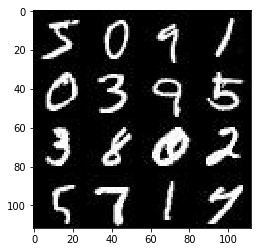
- show_n_images = 9
- mnist_images = get_batch(glob(os.path.join(data_dir, 'img_align_celeba/*.jpg'))[:show_n_images], 28, 28, 'RGB')
- pyplot.imshow(images_square_grid(mnist_images, 'RGB'))
celeba
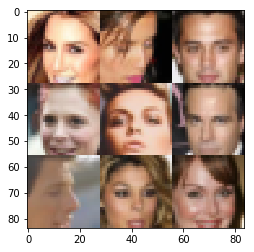
现在我们开始搭建网络
这里我建议用GPU来训练,tensorflow的版本最好是1.1.0
- from distutils.version import LooseVersion
- import warnings
- import tensorflow as tf
- # Check TensorFlow Version
- assert LooseVersion(tf.__version__) >= LooseVersion('1.0'), 'Please use TensorFlow version 1.0 or newer. You are using {}'.format(tf.__version__)
- print('TensorFlow Version: {}'.format(tf.__version__))
- # Check for a GPU
- if not tf.test.gpu_device_name():
- warnings.warn('No GPU found. Please use a GPU to train your neural network.')
- else:
- print('Default GPU Device: {}'.format(tf.test.gpu_device_name()))
接着我们要做的是构建输入
- def model_inputs(image_width, image_height, image_channels, z_dim):
- ## Real imag
- inputs_real = tf.placeholder(tf.float32,(None, image_width,image_height,image_channels), name = 'input_real')
- ## input z
- inputs_z = tf.placeholder(tf.float32,(None, z_dim), name='input_z')
- ## Learning rate
- learning_rate = tf.placeholder(tf.float32, name = 'lr')
- return inputs_real, inputs_z, learning_rate
构建Discriminator
- def discriminator(images, reuse=False):
- """
- Create the discriminator network
- :param images: Tensor of input image(s)
- :param reuse: Boolean if the weights should be reused
- :return: Tuple of (tensor output of the discriminator, tensor logits of the discriminator)
- """
- # TODO: Implement Function
- ## scope here
- with tf.variable_scope('discriminator', reuse=reuse):
- alpha = 0.2 ### leak relu coeff
- # drop out probability
- keep_prob = 0.8
- # input layer 28 * 28 * color channel
- x1 = tf.layers.conv2d(images, 128, 5, strides=2, padding='same',
- kernel_initializer= tf.contrib.layers.xavier_initializer(seed=2))
- ## No batch norm here
- ## leak relu here / alpha = 0.2
- relu1 = tf.maximum(alpha * x1, x1)
- # applied drop out here
- drop1 = tf.nn.dropout(relu1, keep_prob= keep_prob)
- # 14 * 14 * 128
- # Layer 2
- x2 = tf.layers.conv2d(drop1, 256, 5, strides=2, padding='same',
- kernel_initializer= tf.contrib.layers.xavier_initializer(seed=2))
- ## employ batch norm here
- bn2 = tf.layers.batch_normalization(x2, training=True)
- ## leak relu
- relu2 = tf.maximum(alpha * bn2, bn2)
- drop2 = tf.nn.dropout(relu2, keep_prob=keep_prob)
- # 7 * 7 * 256
- # Layer3
- x3 = tf.layers.conv2d(drop2, 512, 5, strides=2, padding='same',
- kernel_initializer= tf.contrib.layers.xavier_initializer(seed=2))
- bn3 = tf.layers.batch_normalization(x3, training=True)
- relu3 = tf.maximum(alpha * bn3, bn3)
- drop3 = tf.nn.dropout(relu3, keep_prob=keep_prob)
- # 4 * 4 * 512
- # Output
- # Flatten
- flatten = tf.reshape(relu3, (-1, 4 * 4 * 512))
- logits = tf.layers.dense(flatten,1)
- # activation
- out = tf.nn.sigmoid(logits)
- return out, logits
接着是 Generator
- def generator(z, out_channel_dim, is_train=True):
- """
- Create the generator network
- :param z: Input z
- :param out_channel_dim: The number of channels in the output image
- :param is_train: Boolean if generator is being used for training
- :return: The tensor output of the generator
- """
- # TODO: Implement Function
- with tf.variable_scope('generator', reuse = not is_train):
- # First Fully connect layer
- x0 = tf.layers.dense(z, 4 * 4 * 512)
- # Reshape
- x0 = tf.reshape(x0,(-1,4,4,512))
- # Use the batch norm
- bn0 = tf.layers.batch_normalization(x0, training= is_train)
- # Leak relu
- relu0 = tf.nn.relu(bn0)
- # 4 * 4 * 512
- # Conv transpose here
- x1 = tf.layers.conv2d_transpose(relu0, 256, 4, strides=1, padding='valid')
- bn1 = tf.layers.batch_normalization(x1, training=is_train)
- relu1 = tf.nn.relu(bn1)
- # 7 * 7 * 256
- x2 = tf.layers.conv2d_transpose(relu1, 128, 3, strides=2, padding='same')
- bn2 = tf.layers.batch_normalization(x2, training=is_train)
- relu2 = tf.nn.relu(bn2)
- # 14 * 14 * 128
- # Last cov
- logits = tf.layers.conv2d_transpose(relu2, out_channel_dim, 3, strides=2, padding='same')
- ## without batch norm here
- out = tf.tanh(logits)
- return out
然后我们来定义loss,这里,加入了smoother
- def model_loss(input_real, input_z, out_channel_dim):
- """
- Get the loss for the discriminator and generator
- :param input_real: Images from the real dataset
- :param input_z: Z input
- :param out_channel_dim: The number of channels in the output image
- :return: A tuple of (discriminator loss, generator loss)
- """
- # TODO: Implement Function
- g_model = generator(input_z, out_channel_dim, is_train=True)
- d_model_real, d_logits_real = discriminator(input_real, reuse = False)
- d_model_fake, d_logits_fake = discriminator(g_model, reuse= True)
- ## add smooth here
- smooth = 0.1
- d_loss_real = tf.reduce_mean(
- tf.nn.sigmoid_cross_entropy_with_logits(logits=d_logits_real,
- labels=tf.ones_like(d_model_real) * (1 - smooth)))
- d_loss_fake = tf.reduce_mean(
- tf.nn.sigmoid_cross_entropy_with_logits(logits=d_logits_fake, labels=tf.zeros_like(d_model_fake)))
- g_loss = tf.reduce_mean(
- tf.nn.sigmoid_cross_entropy_with_logits(logits=d_logits_fake,
- labels= tf.ones_like(d_model_fake)))
- d_loss = d_loss_real + d_loss_fake
- return d_loss, g_loss
接着我们需要定义网络优化的过程,这里我们需要用到batch_normlisation, 不懂的话去搜下文档
- def model_opt(d_loss, g_loss, learning_rate, beta1):
- """
- Get optimization operations
- :param d_loss: Discriminator loss Tensor
- :param g_loss: Generator loss Tensor
- :param learning_rate: Learning Rate Placeholder
- :param beta1: The exponential decay rate for the 1st moment in the optimizer
- :return: A tuple of (discriminator training operation, generator training operation)
- """
- t_vars = tf.trainable_variables()
- d_vars = [var for var in t_vars if var.name.startswith('discriminator')]
- g_vars = [var for var in t_vars if var.name.startswith('generator')]
- update_ops = tf.get_collection(tf.GraphKeys.UPDATE_OPS)
- with tf.control_dependencies(update_ops):
- d_train_opt = tf.train.AdamOptimizer(learning_rate,beta1=beta1).minimize(d_loss,var_list = d_vars)
- g_train_opt = tf.train.AdamOptimizer(learning_rate,beta1=beta1).minimize(g_loss,var_list = g_vars)
- return d_train_opt, g_train_opt
现在,我们网络的模块,损失函数,以及优化的过程都定义好了,现在我们就要开始训练我们的网络了,我们的训练过程定义如下。
- def train(epoch_count, batch_size, z_dim, learning_rate, beta1, get_batches, data_shape, data_image_mode):
- """
- Train the GAN
- :param epoch_count: Number of epochs
- :param batch_size: Batch Size
- :param z_dim: Z dimension
- :param learning_rate: Learning Rate
- :param beta1: The exponential decay rate for the 1st moment in the optimizer
- :param get_batches: Function to get batches
- :param data_shape: Shape of the data
- :param data_image_mode: The image mode to use for images ("RGB" or "L")
- """
- losses = []
- samples = []
- input_real, input_z, lr = model_inputs(data_shape[1], data_shape[2], data_shape[3], z_dim)
- d_loss, g_loss = model_loss(input_real,input_z,data_shape[-1])
- d_opt, g_opt = model_opt(d_loss, g_loss, learning_rate, beta1)
- steps = 0
- with tf.Session() as sess:
- sess.run(tf.global_variables_initializer())
- for epoch_i in range(epoch_count):
- for batch_images in get_batches(batch_size):
- # TODO: Train Model
- steps += 1
- # Reshape the image and pass to Discriminator
- batch_images = batch_images.reshape(batch_size,
- data_shape[1],
- data_shape[2],
- data_shape[3])
- # Rescale the data to -1 and 1
- batch_images = batch_images * 2
- # Sample the noise
- batch_z = np.random.uniform(-1,1,size = (batch_size, z_dim))
- ## Run optimizer
- _ = sess.run(d_opt, feed_dict = {input_real:batch_images,
- input_z:batch_z,
- lr:learning_rate
- })
- _ = sess.run(g_opt, feed_dict = {input_real:batch_images,
- input_z:batch_z,
- lr:learning_rate})
- if steps % 10 == 0:
- train_loss_d = d_loss.eval({input_real:batch_images, input_z:batch_z})
- train_loss_g = g_loss.eval({input_real:batch_images, input_z:batch_z})
- losses.append((train_loss_d,train_loss_g))
- print("Epoch {}/{}...".format(epoch_i+1, epochs),
- "Discriminator Loss: {:.4f}...".format(train_loss_d),
- "Generator Loss: {:.4f}".format(train_loss_g))
- if steps % 100 == 0:
- show_generator_output(sess, 25, input_z, data_shape[-1], data_image_mode)
开始训练,超参数的设置
对于MNIST
- batch_size = 64
- z_dim = 100
- learning_rate = 0.001
- beta1 = 0.5
- epochs = 2
- mnist_dataset = helper.Dataset('mnist', glob(os.path.join(data_dir, 'mnist/*.jpg')))
- with tf.Graph().as_default():
- train(epochs, batch_size, z_dim, learning_rate, beta1, mnist_dataset.get_batches,
- mnist_dataset.shape, mnist_dataset.image_mode)
训练效果如下
开始的时候,网络的参数很差,我们生成的手写数字的效果自然就不好
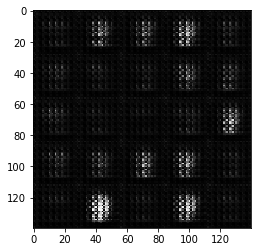
随着训练的进行,轮廓逐渐清晰,效果如下,到最后:
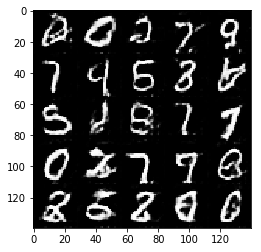
我们看到数字的轮廓基本是清晰可以辨认的,当然,这只是两个epoch的结果,如果有足够的时间经过更长时间的训练,效果会更好。
我们同样展示下对celeba人脸数据集的训练结果
- batch_size = 32
- z_dim = 100
- learning_rate = 0.001
- beta1 = 0.4
- epochs = 1
- celeba_dataset = helper.Dataset('celeba', glob(os.path.join(data_dir, 'img_align_celeba/*.jpg')))
- with tf.Graph().as_default():
- train(epochs, batch_size, z_dim, learning_rate, beta1, celeba_dataset.get_batches,
- celeba_dataset.shape, celeba_dataset.image_mode)
训练开始:
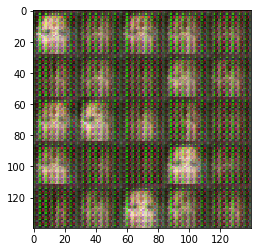
经过一个epoch之后:
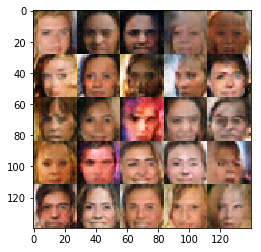
人脸的轮廓基本清晰了。
这里我们就是用了DCGAN最简单的方式来实现,原理过程说的不是很详细,同时,可能这个参数设置也不是很合理,训练的也不够成分,但是我想可以帮大家快速掌握实现一个简单的DCGAN的方法了。
利用tensorflow训练简单的生成对抗网络GAN的更多相关文章
- TensorFlow从1到2(十二)生成对抗网络GAN和图片自动生成
生成对抗网络的概念 上一篇中介绍的VAE自动编码器具备了一定程度的创造特征,能够"无中生有"的由一组随机数向量生成手写字符的图片. 这个"创造能力"我们在模型中 ...
- 人工智能中小样本问题相关的系列模型演变及学习笔记(二):生成对抗网络 GAN
[说在前面]本人博客新手一枚,象牙塔的老白,职业场的小白.以下内容仅为个人见解,欢迎批评指正,不喜勿喷![握手][握手] [再啰嗦一下]本文衔接上一个随笔:人工智能中小样本问题相关的系列模型演变及学习 ...
- 生成对抗网络GAN介绍
GAN原理 生成对抗网络GAN由生成器和判别器两部分组成: 判别器是常规的神经网络分类器,一半时间判别器接收来自训练数据中的真实图像,另一半时间收到来自生成器中的虚假图像.训练判别器使得对于真实图像, ...
- 用MXNet实现mnist的生成对抗网络(GAN)
用MXNet实现mnist的生成对抗网络(GAN) 生成式对抗网络(Generative Adversarial Network,简称GAN)由一个生成网络与一个判别网络组成.生成网络从潜在空间(la ...
- 深度学习框架PyTorch一书的学习-第七章-生成对抗网络(GAN)
参考:https://github.com/chenyuntc/pytorch-book/tree/v1.0/chapter7-GAN生成动漫头像 GAN解决了非监督学习中的著名问题:给定一批样本,训 ...
- 生成对抗网络(GAN)
基本思想 GAN全称生成对抗网络,是生成模型的一种,而他的训练则是处于一种对抗博弈状态中的. 譬如:我要升职加薪,你领导力还不行,我现在领导力有了要升职加薪,你执行力还不行,我现在执行力有了要升职加薪 ...
- 深度学习-生成对抗网络GAN笔记
生成对抗网络(GAN)由2个重要的部分构成: 生成器G(Generator):通过机器生成数据(大部分情况下是图像),目的是“骗过”判别器 判别器D(Discriminator):判断这张图像是真实的 ...
- 科普 | 生成对抗网络(GAN)的发展史
来源:https://en.wikipedia.org/wiki/Edmond_de_Belamy 五年前,Generative Adversarial Networks(GANs)在深度学习领域掀起 ...
- 在浏览器中进行深度学习:TensorFlow.js (八)生成对抗网络 (GAN
Generative Adversarial Network 是深度学习中非常有趣的一种方法.GAN最早源自Ian Goodfellow的这篇论文.LeCun对GAN给出了极高的评价: “There ...
随机推荐
- Golang之go 命令用法
Go 命令 Go 命令 Go语言自带有一套完整的命令操作工具,你可以通过在命令行中执行go来查看它们: 图1.3 Go命令显示详细的信息 这些命令对于我们平时编写的代码非常有用,接下来就让我们了解一些 ...
- Java jdk 8 新特性
list 统计(求和.最大.最小.平均) 第一种方式 int suma = listUsers.stream().map(e -> e.getAge()).reduce(Integer::sum ...
- 一款APP的交互文档从撰写到交付
我第一份工作的设计总监是前百度设计师,34岁,一线设计12年:今年聊天说转了产品总监,如今39岁还活跃在行业中…… 我第二份工作的部门总监是前腾讯工程师,38岁,一线开发14年:2年前在Q群里跟我们说 ...
- jsp札记
日期格式化 <s:date name="creaetime" format="yyyy-MM-dd HH:mm:ss" /> <base hr ...
- hadoop群集 启动
###注意:严格按照下面的步骤 .5启动zookeeper集群(分别在itcast04.itcast05.itcast06上启动zk) cd /itcast/zookeeper-/bin/ ./zkS ...
- Android无线调试(转)
Android无线调试——抛开USB数据线 开发Android的朋友都知道,真机调试需要把手机与PC相连,然后把应用部署到真机上进行安装和调试.长长的USB线显得很麻烦,而且如果需要USB接口与其他设 ...
- python之零碎知识
一 join方法 主要是做字符串的拼接:join后面跟的类型必须是要可迭代得到对象 for循环的对象是可迭代对象 # result = "".join(li) # print(re ...
- Linux上查看造成IO高负载的进程
方法1:使用iotop工具这是一个python脚本工具,使用方法如:iotop -o方法2:使用工具dmesg使用dmesg之前,需要先开启内核的IO监控:echo 1 >/proc/sys/v ...
- log4j日志文件路径设置
假设有如下标准化的目录结构: $HOME |-- log |-- conf |-- bin |-- lib |-- data jar包放在lib目录,启动脚本放在bin目录,日志文件放在log目录,配 ...
- tar、7z(7zip)压缩/解压缩指令的使用
本文介绍tar.7z指令的使用方法 tar指令 在Linux中,使用的最多的压缩/解压缩指令就是tar指令了. tar指令用来将多个文件/目录结构打包.在实际使用中,往往使用tar对压缩的支持,即同时 ...
